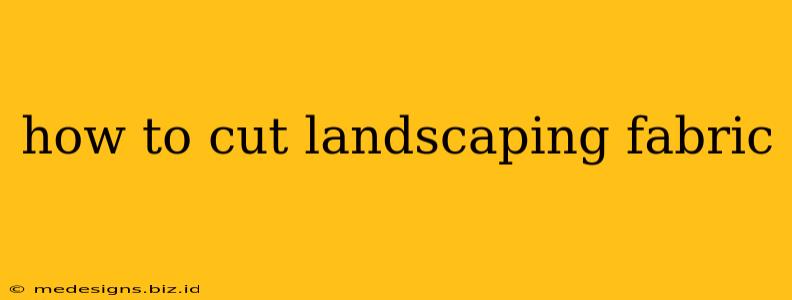Landscaping fabric, also known as weed barrier fabric, is a crucial element for any successful landscaping project. It helps suppress weeds, retain moisture, and improve the overall health of your plants. But before you can reap these benefits, you need to know how to cut it effectively. This guide will walk you through the process, ensuring a clean, efficient cut every time.
Choosing the Right Tools
The key to a successful cut lies in using the appropriate tools. Avoid using dull or damaged tools, as they can tear the fabric, leading to uneven edges and potentially compromising its effectiveness. Here's what you'll need:
- Sharp Utility Knife: This is your primary tool. A sharp blade ensures a clean cut and prevents fraying. Look for a knife with replaceable blades for optimal sharpness.
- Heavy-Duty Scissors: For smaller, more intricate cuts, heavy-duty scissors can be useful. Avoid regular household scissors, as they may struggle with the thickness of the landscaping fabric.
- Measuring Tape: Accurate measurements are essential to avoid wasting fabric.
- Marker or Chalk: Use a marker or chalk to mark your cutting lines on the fabric for precise cuts. Choose a marker that won't bleed or fade easily.
Cutting Techniques for Different Situations
The best cutting method depends on the size and shape of the area you're covering.
Cutting Straight Lines:
- Measure and Mark: Use your measuring tape to determine the exact dimensions you need and mark the cutting line with a marker or chalk.
- Stable Surface: Place the landscaping fabric on a flat, stable surface. This will ensure a clean, even cut.
- Controlled Cuts: Holding the knife at a slight angle, make slow, deliberate cuts along the marked line. Avoid rushing, as this can lead to uneven edges.
- Replace Blades: If you notice the blade becoming dull, replace it immediately to maintain a clean cut.
Cutting Curves and Irregular Shapes:
- Precise Marking: Carefully mark the curved or irregular shape on the fabric using a marker or chalk.
- Small Incisions: Make small, incremental cuts along the marked line, following the curve as closely as possible.
- Smooth the Edges: Once you've cut the shape, you may need to smooth the edges to prevent fraying. This can be done carefully with your scissors.
Cutting Around Existing Plants:
- Accurate Measurement: Measure the space around each plant, ensuring you leave enough fabric to cover the root area without smothering the plant.
- Cut with Precision: Carefully cut around each plant, leaving enough space for growth. Use a combination of the utility knife and scissors for this task.
Tips for Preventing Fraying
Landscaping fabric can fray over time, particularly if not cut correctly. Here are a few tips to minimize fraying:
- Sharp Blades: Using a sharp blade is the most important factor in preventing fraying.
- Avoid Pulling: Don't pull the fabric while cutting. Let the blade do the work.
- Heat Sealing (Optional): For added protection against fraying, you can use a heat sealing tool (often used in fabric crafts) to seal the edges of the cut fabric. This is especially helpful for large projects.
Maintaining Your Tools
Keeping your tools sharp and in good condition is crucial for a clean cut every time. Regularly clean your knife and scissors and replace blades as needed. Proper tool maintenance will ensure that your landscaping fabric installation is both efficient and effective.
By following these steps, you can confidently cut your landscaping fabric, ensuring a professional-looking and long-lasting weed barrier for your garden or landscaping project. Remember, precision and patience are key to a successful cut!
